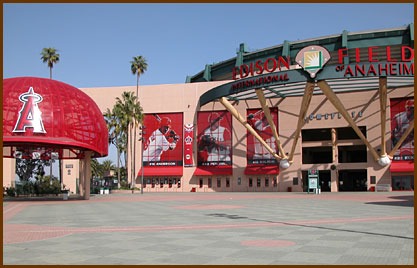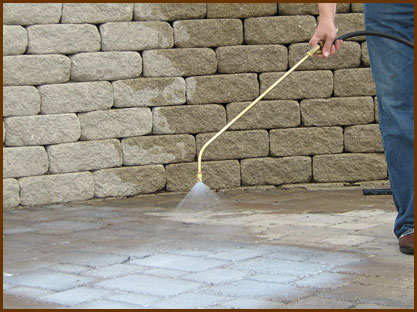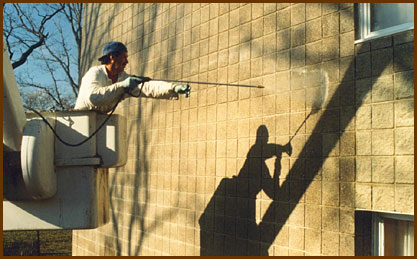September 2008
Cleaners and Sealants

Some of the changes in the way masonry products are cleaned and sealed relate to the “green” movement and environmental concerns, along with new masonry products such as manufactured stone and concrete brick.
By Tom Inglesby
There are always compromises required when dealing with construction requirements, new materials and environmental concerns. For example, new materials like manufactured stone veneers and concrete bricks have challenged contractors to change their ways of post-construction cleaning to prevent color damage and streaking.
“You use a different type of cleaner to do new construction clean down on thin brick than you do on either clay or concrete masonries,” says Gary Henry with PROSOCO in Lawrence, Kan. “The main difference between the clay and concrete is that clay is acid resistant, and concrete is acid soluble. You need a certain amount of acid, just a small amount of highly purified, high-grade acid that is harnessed by surfactants and inhibitors and wetting agents.
“You need that acid to dissolve that excess mortar, so that you can rinse it off,” Henry continues. “Since clay brick is acid resistant, you can use a more aggressive cleaner, one that has a more powerful acid, even though that acid is still harnessed.”
When discussing acids, taking care to prevent injury is always the most important consideration, followed by taking care of the owner’s investment. Let’s take some specific cases of using cleaners on newer substrates. Here’s the word from Larry Kotke, VP of operations for Diedrich Technologies Inc. in Oak Creek, Wisc.
“With some of the new types of custom brick, burnished block, concrete brick and architectural block, manufacturers are recommending cleaners that do not contain hydrochloric (muriatic) acid,” Kotke says. “For the cleaning of custom brick, burnished block, concrete brick and the architectural block, most cleaners are phosphoric acid based products. These will do a good job of cleaning, but they must be used before the mortar has cured completely, usually between seven and 14 days after construction of the wall.
“For cleaning manufactured stone new construction, hydrochloric and phosphoric acid based products can easily remove the fine colored finish from the stone,” he continues. “We developed a product which utilizes an organic proton with chelator and no mineral acids. Diedrich Green Clean 250 has proven very effective, but again the cleaning must commence much earlier than with conventional cleaners. For this product to be effective, the cleaning must be done within three to seven days of construction for best results.”

Kotke says to test cleaner samples to determine product suitability, dilution rates, and dwell times for the particular product. “Too many times, contactors will forego doing the test samples and find out that its taking two applications of a product to achieve the results necessary for a successful project and they bid it with one application, or they had to switch to a different product,” he says. “The same can be said for water repellents. The porosity of the surface and the type of brick, block, concrete or stone usually will dictate the type of water repellent product would be best suited, whether it is a silane, siloxane, silicone polymer, or acrylic types of product.”
Often, the dyes used on newer manufactured products don’t penetrate far below the surface. This presents a problem when using a pressure washer at clean-up, since the water flow can remove the color the architect and owner spent so much effort to obtain. And, because the dyes used on some veneers are water based, they don’t adhere well, even to the surface. A pressure washer might take off more than the intended residue. So, most contractors turn to acid washes, which are not necessarily the best approach today.
A little history on using acids: “A long time ago, when all you had was red clay brick and grey mortar and before proprietary cleaners for masonry had been invented, muriatic acid was all there was for cleaning masonry,” Henry says. “And, it wasn’t too bad of a choice then, because red clay brick is very highly acid resistant. So, you would slap the acid on raw, rinse it off and you’d be done. Since then, there have been a lot of advances, not just in masonry, but in construction materials other than masonry; aluminum window frames and all kind of things that can be terribly damaged by raw acid. White brick is a good example of a clay masonry that’s still very acid sensitive.”
To get white or beige colored brick, foundries use vanadium salts, which are quite soluble in acid. If you try to clean those bricks with raw acid, that acid acts with the vanadium salts and creates horrible stains.
“We sell products to repair that damage,” says Henry, “and it is repairable in some cases, but it’s expensive and the contractor usually bears the brunt of the cost.”
In other cases, muriatic acid etches and dissolves mortar joints, and that damage is not easily repairable. Also, muriatic acid has a yellow color, because there are particles from the industrial processes that created it still floating around in the acid. That can stain any brick work.
According to Bert Adams, president of Glaze ‘N Seal in Irvine, Calif., “Another recent product is what I would call a ‘safety stripper.’ These products are not as harsh to use but, in general, they take much longer to be effective. Some of them, such as the soy gel products, will often remove difficult coatings if you have enough time and patience.”
With the growing need for contractors to go green, cleaning and sealing products that conform to various environmental standards, such as those vested in the LEED (Leadership in Energy and Environmental Design) specifications, can be a benefit from the environment standpoint and from the public image of a concerned contractor and industry.
Many states have legislated rules on levels of VOC (volatile organic compounds) allowed in a variety of chemicals. “That’s been a factor for 30 years, a gradual push towards lower VOC types of products,” Adams says. “That push initially came primarily at the state and local levels, and then migrated to the national scene, but it is also being encouraged by a growing percentage of contractors and homeowners who are looking for ‘green’ types of products.
“Our business began with high VOC solvent based products, and our home market is California which has been one of the leaders in reducing VOC levels,” he continues. “As a result, we have had to, many times, reformulate and modify products to ensure that they continue to meet the appropriate regulations. Additionally, we have pushed aggressively to add a number of water-based products, which in general have much lower levels of VOC and are an alternative.”
This can be costly for the vendor but, overall, a good thing for the industry and environment. “In Southern California, the VOC regulations are the strictest in the country for masonry sealers ??? the VOC limit a couple years ago was lowered to 100 VOC when most of the country is allowing 400 to 600 ??? and we’ve introduced a product that meets those requirements and has literally lowered the VOC at least 75 percent from our previous products,” says Adams.
The sealant industry, then, is at the forefront of the green movement within the masonry field. Jennifer Crisman, technical marketing manager for Euclid Chemical in Cleveland, Ohio, explains, “The most significant impact on the masonry sealer/sealing business is the ever-changing VOC regulations, which become more strict and widespread every year. The Federal AIM (Architectural and Industrial Maintenance) Coatings Rule went into effect nationally in 1999, placing limits on the VOC allowed in many types of concrete and masonry construction products, including sealers. The Federal AIM Coatings Rule is applicable throughout the United States, but states or locales with more stringent VOC requirements override less stringent provisions of the National Rule, as is the case for most of the rules in California and in the Northeast.”
The VOC limits of the Federal AIM Rule are high enough that they allow for solvent-based masonry sealers, but the more strict local laws on the east coast (from Maine down to northern Virginia) and in California do not. In these areas, contractors are restricted to using water-based sealers or sealers formulated with “exempt” solvents. The EPA is currently revising the AIM Coatings Rule, and VOC limits are expected to drop to levels such that solvent based concrete and masonry sealers would be illegal nationwide. The new Federal AIM Rule is expected to go into effect in January 2009.
Crisman notes, “The only new chemical formulas in masonry sealing involve the use of ‘exempt’ solvents, such as acetone and tertiary-butyl acetate (TBAC) as the liquid carrier. Acetone and TBAC are considered exempt from VOC calculations, because they do not cause air pollution. Where traditional solvent-based masonry sealers might use xylene as the carrier (xylene is a VOC), the sealers using an exempt solvent are VOC compliant and can be used in the strict VOC regulated areas of the U.S.”
Dave Maietta, president/CEO of Multicoat Corp. in Rancho Santa Margarita, Calif., adds to the discussion of VOC. “Water-based sealers that are less than 50 grams per liter will get you LEED credits and be considered green friendly,” he says. “We make a pigmented sealer, and we make a clear sealer for masonry that fall well within the standards of the VOC regulations. I know those rules are going to get stronger within the next couple of years.”

As the cleaner side of things has been challenged by new masonry products, so has the sealer side. In most cases, however, there has been little need for changes to the chemicals or techniques for applying them. “It’s going to be much the same as what you would use on clay brick or concrete block or real stone,” says Maietta. “You can use what you’re using on artificial stone or concrete stone that they’re using now; the sealers are compatible.”
And, as Zach Fatla, brand manager for SureBond in Madison, Wisc., explains, “Customers expect better performance, immediate application and environmentally friendly products. The continued increase in VOC regulations nationwide has restricted many cleaners and sealers, and this is especially true in states like California and the OTC (Ozone Transport Commission) regulated states in the Northeast, mid-Atlantic and now the Midwest.”
His suggestion? “Always make sure that sealing products are going to perform to the desired effects of the customer’s project, be that aesthetic appearance, stain resistance, traffic performance, etc. The sealing products should act as a compliment to the masonry installation and ensure the continued appearance and performance.”
This is good advice, regardless of the VOC limits, that pertains to cleaning as well as sealing the product.
|
|